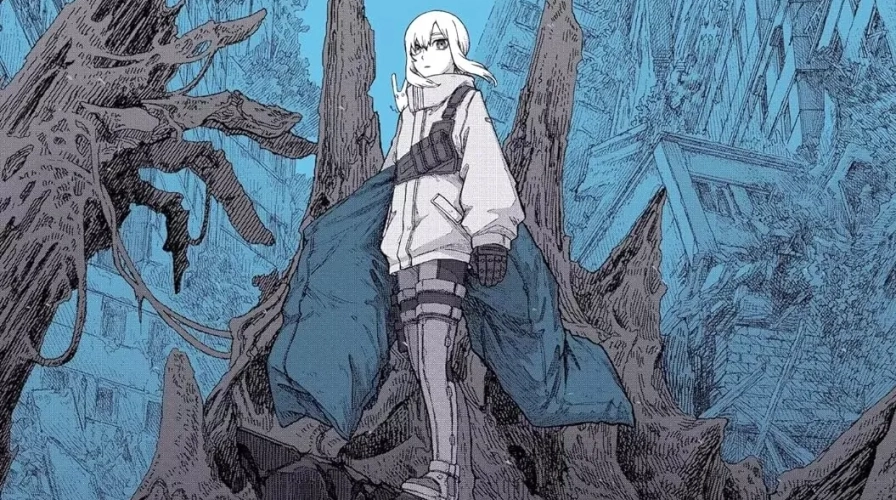As civilization faces increasing collapse, stories of apocalyptic ruin are multiplying as fast as heat records. While these tales often carry a grim tone, *Mission in the Apocalypse* stands out, offering a nostalgic view of the end of the world.
The Devastated World of *Mission in the Apocalypse*
Writer and illustrator Haruo Iwamune wastes no time plunging readers into the story. On the first page, a young girl awakens in a ruined metropolis devoid of any human life. By the second page, we glimpse a colossal creature collapsed on a skyscraper. Set in a post-catastrophic world, *Mission in the Apocalypse* quickly establishes its eerie, desolate tone.
Yet, the mystery runs deep. The protagonist’s name remains unknown until the final chapter, and the timeline of events is deliberately ambiguous. The collapse seems ancient—she stumbles upon the concept of cinema as if discovering an artifact. Curiously, nature hasn’t entirely reclaimed the ruins. The setting features a mix of futuristic robots, contemporary weaponry, and 1980s-era digital clocks and wristwatches.
Alone in this barren world, the girl speaks sparingly, and much about the city’s fate and its inhabitants remains a mystery. An artificial narrative device explains the backstory in the first chapter: humanity was decimated when new lifeforms, known as the “Condemned,” appeared. Like the colonization of the Americas, this invasion brought violence but was primarily devastating due to a virus. These creatures spread deadly miasmas, introducing diseases that overwhelmed human biology. Uniquely, this “crystalline plague” manifests as multiplying cubes on the body.
The girl’s role is revealed early on: she is tasked with decontaminating areas and searching for human survivors. However, she has completed only 0.002% of her mission. The enormity of her task seems insurmountable, but hints suggest she may not be human. Dubbed the “eternal child” elsewhere, her perfect demeanor raises questions about her true nature.

Blame with a Soft Touch
The visuals of *Mission in the Apocalypse* echo the monumental, desolate architecture of Tsutomu Nihei’s *Blame*. The protagonist, experienced and confident, selects weapons and combat gear before each mission. Although the Condemned remain a threat, most of these creatures are as dead as the humans they outlived.
The robot and monster designs are a highlight of this first volume. Each mission showcases a variety of post-destruction settings, from modern metropolises to medieval cities. The narrative casts a pessimistic view of humanity, which failed to overcome both external threats and internal divisions.
Despite its post-apocalyptic backdrop, *Mission in the Apocalypse* focuses on the protagonist’s quiet, everyday life. Through episodic chapters, readers witness moments like cremating bodies, watching a film, and moving supplies. The “eternal child” visits a hidden hideout to prepare meals, choosing a spicy dish. She dons appropriate attire for the solemn task of cremation. So far, the series lacks a continuous narrative thread.
Though the premise hints at warfare, the dominant atmosphere is one of calm and tenderness. The protagonist’s serene demeanor contrasts with the harsh world around her, and she often interacts with a small, white, rabbit-like creature. Missions are devoid of tension or surprise attacks, offering instead a nostalgic walk through a destroyed world.
This juxtaposition of a violent world and a gentle tone is reflected in the artwork. Multiple artists contribute to the series. The hyper-realistic, detail-rich backgrounds—particularly for weapons and military vehicles—are rendered in dark, gray tones. In contrast, the protagonist’s stylized, rounded design leaves ample white space, softening the overall mood. A third art style emerges in a film sequence, featuring more textured, line-heavy visuals.
Published by Delcourt, *Mission in the Apocalypse* delivers a compelling debut, blending the gravity of a post-apocalyptic setting with the gentle presence of its heroine. This quiet existence is disrupted as she ventures outside, and a surprising twist in the final episode leaves readers eager to explore more of this strange world.
Discover more futuristic journeys in manga with Atom: The Beginning and Kaiju Defense Force.




Comments (0)